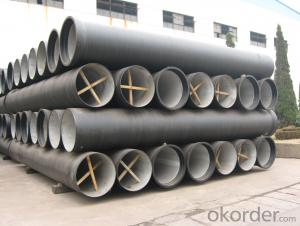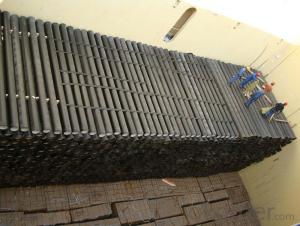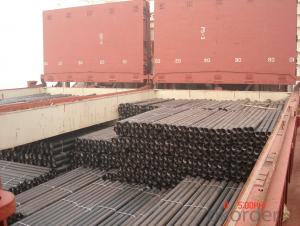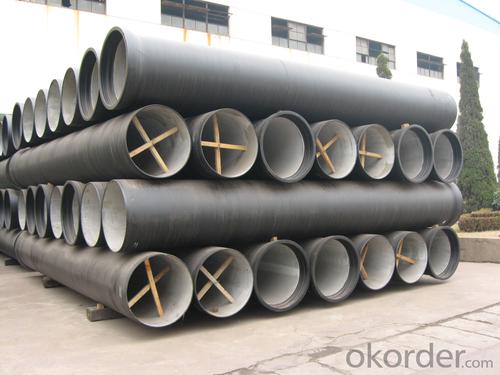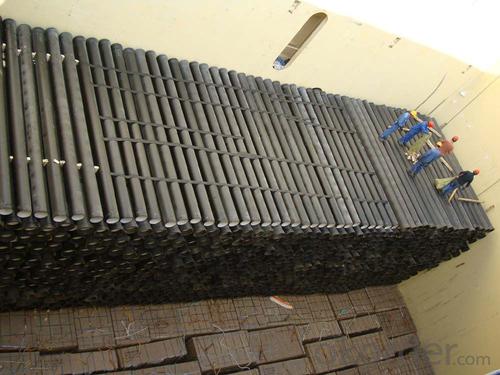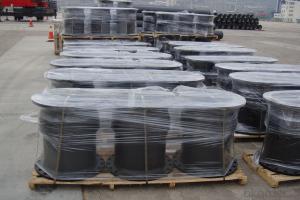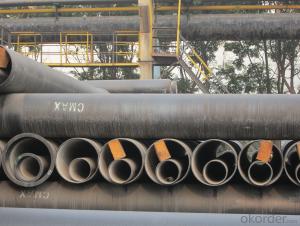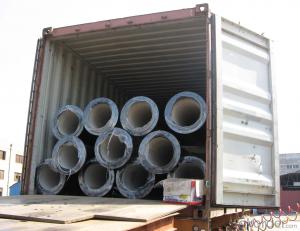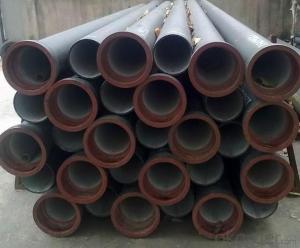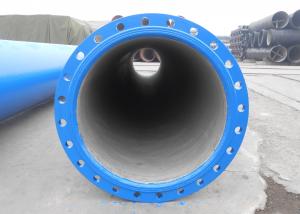DUCTILE IRON PIPE DN600 C
- Loading Port:
- China Main Port
- Payment Terms:
- TT OR LC
- Min Order Qty:
- -
- Supply Capability:
- 30000tons m.t./month
OKorder Service Pledge
OKorder Financial Service
You Might Also Like
Specification:
1) The standard of pipe: ISO2531:1998, K9
2) Effective length: 6m
3) Inner cement line: Portland cement line as per ISO4179
4) Zinc coating: at least 130g/m2 as per ISO8179
5) Bitumen painting: at least 70um as per ISO8179
6) With 100% quantity of NBR ring, or SBR ring, or EPDM ring as per ISO4633
7) DN80mm-800mm
8) High strength, lighter than grey iron, good corrosion resistance, no furring, small flow resistance, easy fixing, long life tome about 100 yeas
9) Produced by Hangzhou chunfeng machine
10) Checked by automatic inspection equipment
11) Composition:
Chemical composition | | | | |||
Chemical composition | Ductile Cast Iron Pipe (%) | Grey iron pipe (%) | Steel pipe (%) | | | |
C | 3.5-4.0 | 3.2-3.8 | 0.1-0.2 | | | |
Si | 1.9-2.6 | 1.4-2.2 | 0.15-0.4 | | | |
Mn | 0.15-0.45 | 0.4-0.6 | 0.3-0.6 | | | |
P | ≤0.06 | ≤0.3 | 0.02-0.03 | | | |
S | ≤0.02 | ≤0.1 | 0.02-0.03 | | | |
Mg | 0.03-0.06 |
|
| | | |
12) Feature:
Mechanical properties | | | | |||
| Ductile Cast Iron Pipe | Grey Iron Pipe | Steel Pipe | | | |
Tensile Strength(Mpa) | ≥420 | 150-260 | ≥400 | | | |
Yield Strength(Mpa) | ≥300 | No Confirmation | No Confirmation | | | |
Bending Strength(Mpa) | ≥590 | 200-360 | ≥400 | | | |
Elongation (%) | ≥10 | Neglected | ≥18 | | | |
Brinell Hardness(HBS) | ≤230 | ≤230 | About 140 | | | |
13) T type mechanical joint
14) Packing: in bulk or container
- Q: What are the typical pressure surge protection measures for ductile iron pipe?
- There are several typical pressure surge protection measures for ductile iron pipe that help ensure its integrity and longevity. These measures include: 1. Surge tanks: Surge tanks are commonly used to absorb pressure surges and minimize their impact on the ductile iron pipe. These tanks are typically installed at critical points in the pipeline system, such as at pump stations or near valves, to provide a reservoir for excess pressure. 2. Air release valves: Air release valves are essential components in ductile iron pipe systems that help release trapped air and prevent the formation of air pockets. These valves help maintain a stable pressure within the pipe and reduce the risk of pressure surges during operation or sudden changes in flow. 3. Pressure relief valves: Pressure relief valves are designed to protect ductile iron pipes by releasing excess pressure when it exceeds a predetermined threshold. These valves are typically installed at strategic locations in the pipeline system and are set to open when the pressure exceeds a safe limit, diverting the excess pressure to prevent damage to the pipe. 4. Surge suppressors: Surge suppressors are devices that are installed in ductile iron pipe systems to absorb and dissipate pressure surges. These devices act as shock absorbers, reducing the impact of pressure fluctuations and preventing damage to the pipe. Surge suppressors are particularly effective in situations where pressure surges are frequent or severe. 5. Pipe wall thickness: Another crucial measure for pressure surge protection in ductile iron pipe is ensuring an appropriate pipe wall thickness. By selecting a pipe with the correct wall thickness, engineers can ensure that the pipe can withstand the pressure surges it may encounter during operation. This helps prevent pipe failure or rupture due to excessive pressure. It is important to note that the specific pressure surge protection measures implemented for ductile iron pipe may vary depending on the specific application, pipe size, operating conditions, and regulatory requirements. Consulting with experts in pipeline engineering and design is crucial to determine the most suitable pressure surge protection measures for a particular ductile iron pipe system.
- Q: What are the common methods for leak detection in ductile iron pipes?
- Professionals in the field commonly utilize various techniques to detect and locate leaks in ductile iron pipes. These methods play a crucial role in timely leak identification. 1. Acoustic Leak Detection: By employing specialized equipment, professionals listen for the sound of water escaping from the pipe. This equipment detects the leak's sound and aids in pinpointing its exact location. This technique is effective for both pressurized and non-pressurized pipes. 2. Visual Inspection: Physically inspecting the pipe system for visible signs of leaks, such as water stains, wet spots, or puddles, constitutes visual inspection. This relatively straightforward method proves effective in detecting visible leaks in accessible areas. 3. Pressure Testing: During installation or maintenance, pressure testing involves pressurizing the pipe system and monitoring pressure drops. A decrease in pressure signifies the presence of a leak. This method is particularly useful for identifying leaks in inaccessible areas. 4. Infrared Thermography: Infrared cameras detect leaks by measuring temperature variations. The camera can identify temperature differences caused by water escaping from a pipe. This technique is especially efficient in identifying concealed leaks behind walls or underground. 5. Tracer Gas Testing: Tracer gas testing entails injecting a specific gas, such as helium or hydrogen, into the pipe system. In the event of a leak, the gas escapes and can be detected using specialized equipment. This highly sensitive method can locate even minute leaks. 6. Soil Gas Monitoring: Monitoring the soil surrounding the pipe allows professionals to detect gases emitted by leaking water. Analyzing the composition of the soil gas aids in determining the leak's location. It is essential to consider the specific circumstances, such as pipe system size, accessibility, and leak severity when selecting a method. Combining multiple techniques may be necessary to ensure accurate and comprehensive leak detection.
- Q: Can ductile iron pipes be used for agricultural applications?
- Yes, ductile iron pipes can be used for agricultural applications. Ductile iron pipes are known for their durability, strength, and corrosion resistance, making them suitable for various agricultural applications such as irrigation systems, water supply networks, and drainage systems.
- Q: What are the environmental benefits of using ductile iron pipe?
- Ductile iron pipe offers several environmental benefits. Firstly, it is made from recycled materials, reducing the need for extracting new resources. Secondly, it has a long lifespan, typically lasting over 100 years, reducing the need for frequent replacements and minimizing waste. Additionally, ductile iron pipes have a low carbon footprint compared to other materials, contributing to lower greenhouse gas emissions. Lastly, these pipes have excellent corrosion resistance, reducing the risk of leaks and contamination of water sources, thus protecting the environment.
- Q: Are ductile iron pipes resistant to seismic events?
- Yes, ductile iron pipes are resistant to seismic events. Ductile iron has excellent strength and flexibility, allowing it to withstand ground movement during earthquakes without fracturing or failing. This makes it a reliable choice for underground infrastructure in areas prone to seismic activity.
- Q: Can the underground cast iron pipes be connected with clamps to form buttress?
- The hoop has the advantages of beautiful appearance, convenient operation, strong clamping force, good sealing performance, etc.. Mainly used for connecting and fastening vehicle, ship, diesel engine, gasoline engine, machine tools, fire, and other machinery and equipment, chemical equipment general nylon hose, plastic hose, hose cloth, water interface and seal etc..
- Q: Are ductile iron pipes suitable for use in hydropower projects?
- Yes, ductile iron pipes are suitable for use in hydropower projects. Ductile iron pipes have a high tensile strength and are resistant to corrosion, making them ideal for applications in hydropower projects where water flow and pressure are involved. They are capable of withstanding high pressure and are durable, ensuring long-term reliability and safety in hydropower systems. Additionally, ductile iron pipes are cost-effective compared to other materials like steel, making them a popular choice for hydropower projects. Overall, ductile iron pipes offer the necessary characteristics and performance qualities required for the demanding conditions of hydropower projects.
- Q: The difference between spheroidal graphite cast iron pipe and HDPE water supply pipe
- (4) HDPE pipes do not need corrosion protection. If the water supply pipeline is made of ductile iron pipe, the inner and outer walls of the ductile iron pipe shall be treated with corrosion protection.(5) the normal service life of the ductile iron pipe is 20~25 years after the pipe is treated by inner and outer walls. The HDPE tube has no corrosion, and the normal service life is 50 years.
- Q: What are the typical joint restraint requirements for ductile iron pipes in seismic zones?
- The typical joint restraint requirements for ductile iron pipes in seismic zones include using flexible mechanical joints, such as push-on joints or restrained joints. These joints are designed to allow movement and flexibility during seismic events, reducing the risk of pipe failure or damage. Additionally, proper anchoring and bracing of the pipes at critical locations, such as bends or changes in direction, is necessary to prevent excessive movement and ensure the integrity of the pipeline system.
- Q: What are the advantages of using ductile iron pipe?
- There are several advantages of using ductile iron pipe. Firstly, it has a high tensile strength, allowing it to withstand high-pressure conditions without deformation or bursting. Secondly, it has excellent corrosion resistance, making it suitable for use in various environments, including underground and underwater applications. Additionally, ductile iron pipe is highly durable and long-lasting, reducing the need for frequent replacements. It is also resistant to fire and has good seismic performance. Lastly, ductile iron pipe offers easy installation and maintenance due to its flexibility and adaptability.
Send your message to us
DUCTILE IRON PIPE DN600 C
- Loading Port:
- China Main Port
- Payment Terms:
- TT OR LC
- Min Order Qty:
- -
- Supply Capability:
- 30000tons m.t./month
OKorder Service Pledge
OKorder Financial Service
Similar products
Hot products
Hot Searches
Related keywords
